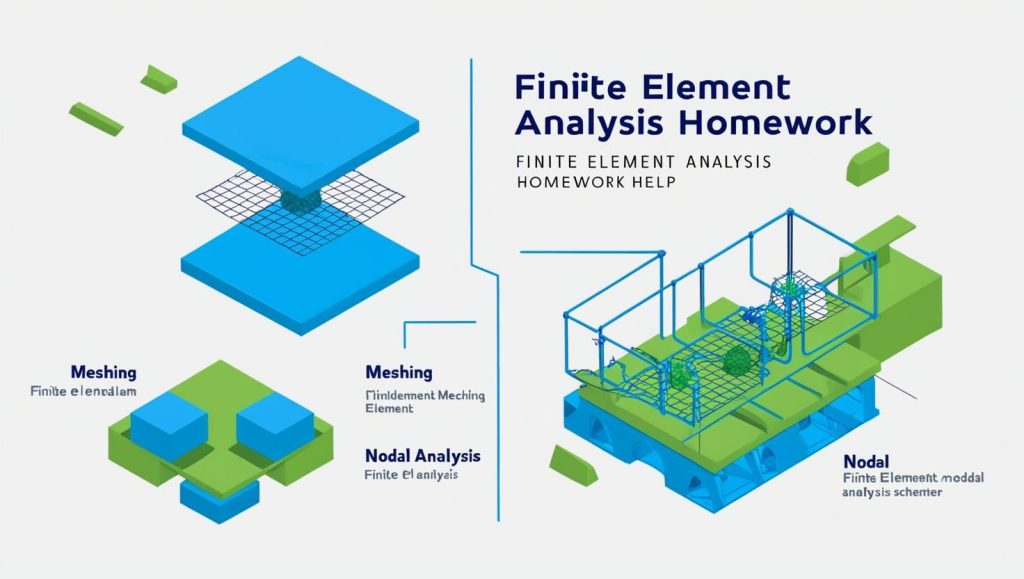Introduction: Why Finite Element Analysis Homework Help is Essential
Finite Element Analysis (FEA) is a crucial subject in mechanical, civil, aerospace, and structural engineering, helping engineers analyze complex structures and systems using numerical methods. FEA allows engineers to break down complicated problems into smaller, manageable elements, making it possible to predict stress, deformation, and failure points.
Many students face challenges in meshing, boundary conditions, element selection, and numerical methods in FEA assignments. This Finite Element Analysis Homework Help guide covers key concepts, problem-solving approaches, and useful resources to help students excel in their coursework.

What is Finite Element Analysis (FEA)?
Finite Element Analysis (FEA) is a computational technique used to solve structural, thermal, fluid, and electromagnetic problems. It involves:
✅ Discretization (Meshing): Dividing a structure into smaller elements.
✅ Element Type Selection: Choosing 1D, 2D, or 3D elements for accurate results.
✅ Boundary Conditions: Defining constraints and loads.
✅ Numerical Solutions: Using matrices and stiffness equations to calculate displacements and stresses.
Applications of FEA:
- Structural Engineering: Stress and strain analysis in bridges and buildings.
- Mechanical Engineering: Failure analysis of machine components.
- Aerospace Engineering: Wing deformation under aerodynamic loads.
- Automotive Engineering: Crash simulations for safety testing.
✅ External Resource: MIT OpenCourseWare – Finite Element Analysis
Key Topics in Finite Element Analysis Homework
1. Meshing in Finite Element Analysis
Meshing divides a complex shape into small elements to simplify calculations. The accuracy of an FEA model depends heavily on mesh quality.
📌 Example Question:
What happens if a mesh is too coarse in an FEA simulation?
✅ Solution:
A coarse mesh may lead to inaccurate results due to poor resolution of stress gradients, whereas a fine mesh improves accuracy but increases computational cost.
✅ External Resource: Meshing Guidelines in FEA
2. Types of Elements in FEA
FEA models use different element types based on the problem.
Common FEA Elements:
- 1D Elements: Beams, rods, trusses.
- 2D Elements: Shells, membranes.
- 3D Elements: Solid tetrahedrons, hexahedrons.
📌 Example Question:
Which element type is best for analyzing thin-walled structures?
✅ Solution:
Shell elements are best for thin-walled structures like aircraft fuselages or car bodies, as they efficiently model bending and shear.
✅ External Resource: Types of Finite Elements
3. Stiffness Matrix in Finite Element Method
The stiffness matrix (K) relates forces and displacements in an FEA model: K⋅U=FK \cdot U = FK⋅U=F
Where:
- KKK = Stiffness matrix
- UUU = Displacement vector
- FFF = Force vector
📌 Example Question:
For a 1D bar element, how is the stiffness matrix derived?
✅ Solution:
Using Hooke’s Law and shape functions, the stiffness matrix for a 1D element is: K=AEL[1−1−11]K = \frac{AE}{L} \begin{bmatrix} 1 & -1 \\ -1 & 1 \end{bmatrix}K=LAE[1−1−11]
where AAA is the cross-sectional area, EEE is Young’s modulus, and LLL is the element length.
✅ External Resource: FEA Stiffness Matrix Basics
4. Boundary Conditions and Constraints in FEA
Boundary conditions define how a structure interacts with its surroundings.
📌 Example Question:
What happens if an FEA model has insufficient constraints?
✅ Solution:
If constraints are missing, the system becomes unstable, leading to rigid body motion errors in simulations. Proper fixing or symmetry conditions are required.
✅ External Resource: Boundary Conditions in FEA
Common Finite Element Analysis Homework Problems and Solutions
Problem 1: Stress Analysis of a Cantilever Beam
Question:
A cantilever beam with length L and uniform load q is analyzed using FEA. What is the maximum deflection at the free end?
✅ Solution:
Using FEA beam theory, the maximum deflection is: δmax=qL48EI\delta_{\max} = \frac{qL^4}{8EI}δmax=8EIqL4
where EEE is Young’s modulus and III is the moment of inertia.
✅ External Resource: FEA Beam Analysis
Problem 2: Thermal Analysis Using FEA
Question:
An aluminum plate (conductivity k) has fixed temperatures on opposite sides. How is the heat distribution analyzed using FEA?
✅ Solution:
The heat conduction equation: −k∇2T=Q-k \nabla^2 T = Q −k∇2T=Q
is solved using finite element discretization to obtain nodal temperatures.
✅ External Resource: FEA Thermal Analysis
How to Excel in Finite Element Analysis Homework
- Understand Meshing Techniques: Learn tetrahedral vs. hexahedral elements.
- Master Boundary Conditions: Avoid over- or under-constrained models.
- Use FEA Software: Practice with ANSYS or ABAQUS.
- Study Stiffness Matrix Concepts: Matrix formulation is key to understanding FEA.
- Seek Online Help: Enroll in Coursera’s FEA courses.
Additional Resources for Finite Element Analysis Homework Help
Conclusion: Mastering Finite Element Analysis Homework
Finite Element Analysis is an essential skill for engineering students, helping them analyze real-world structures, thermal conditions, and mechanical components. Understanding meshing, element types, stiffness matrices, and boundary conditions is crucial for excelling in FEA assignments. This Finite Element Analysis Homework Help guide provides structured explanations, problem-solving strategies, and external resources for mastering FEA concepts.


